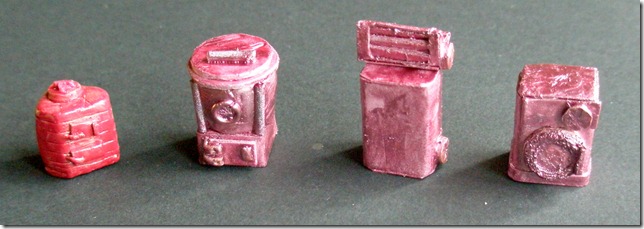Charlotta writes from Sweden that miniatures is a great way of learning history. I couldn’t agree more. Producing the models for mould making over such a range of domestic necessities has stretched my historical knowledge like elastic. I am not producing branded goods because, of course, to do so one needs copyright permission and licences and so forth. Many goods of yesteryear were not branded at all. The actual copper tub that went into the brick housing may have been branded but it is more likely that at first builders and proto-plumbers who knew how to do it just found a suitable tub and got going. Certainly if you research laundry devices you do find enough common ground, for example the arrangement of the wooden handle with two cross pieces of wood for secure grasping in a steamy scullery, to suggest that knowledge was spread by word of mouth prior to branded goods being marketed.
This began to happen during the industrial revolution and by the time the Victorians were flooding the world markets with British branded goods, it was in full swing. So whilst the copper I have made is just a copper the subsequent washing machines are taken from actual surviving examples and advertisements and amalgamated to make a ‘type’ that would have been found in a house of a certain era.
Left to right: a copper with the removable wooden lid and the two doors on the front, one for the fire, the other beneath is to rake out the ash. The next step in evolution is the portable copper. This has the fire box on the bottom, again enclosed in firebricks and those housed in a metal box; permanently fixed above is a braced metal drum with a removable lid. This is only portable in the sense of not needing to be built on the floor and is the first type that could have been ordered from a shop or catalogue and brought to the door at the convenience of late Victorian delivery men and just dumped for someone else to deal with. I have skipped the early electric jobs with the hand wound paddle agitators and moved straight to my mother’s post-war washing machine with the electric mangle.
The mangle swung away from the tub and back over to do the mangling by magical electricity. My mother had a fear of mangling me by accident. This highly unlikely domestic tragedy would have required me to climb up the machine to the mangle, which was shoulder high on her and thrust myself through the rollers without somehow falling in to the tub; how this scenario would eventuate I cannot imagine, but I was warned severely to stay out of the kitchen while she was mangling just in case. Was there a history of mangled children in the family? Are there lurking in long-forgotten albums, pictures of a child on the end of a long row of stiff Edwardians with their three metre long, mangled arm casually resting along the shoulders of the entire assembled company? Wedding albums where the bride’s train has fingers at the end?
Happily we shall never know. Despite the modern convenience of the dangerous electric mangle, washday was still a full day for my mother, at the end of which the machine was emptied into the sink via a hose attached at the circular port at the base and pumped out. Then the agitator paddle, a central stirring device, was removed and dried and the wooden tongs that lifted the wet clothes out and in and fed them through the rollers were dried off and hung up for another week.
And finally the current effort with the built-in obsolescence. White goods are apparently only designed to last five years so we can clog up the planet with yet more junk. That’s fascinating but I don’t think I’ll tell it to my current machine which is sshhhh 9 years old. It does make a very strange noise on the rinse and spin, I think the bearings have gone but it will last a bit longer as long as no one makes a suggestion to the contrary.
It’s a long way from going to the stream and bashing your socks with a rock, which is what happened for most of history, when people bothered to wash their clothes at all. A trip to a clothing museum to examine the underarms of 18th century dresses is enough to give you the galloping fits. Many saints are reported as having the ‘odour of sanctity’ because they renounced washing. Thomas a Becket is one such; apparently after he had been done in it took a good hour for all the lice and vermin to crawl off him and make their way to the door.
Oh washing machines we love you! Air kiss! Mwahh! Mwahh!
~~~~~~~~~~~~~~~~~~~~~~~~~~~~~~~~~~~~~~~~~~~~~~~~~
JaneLaverick.com – squeaky clean

